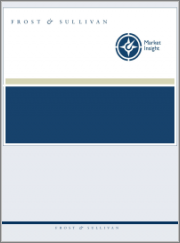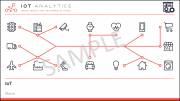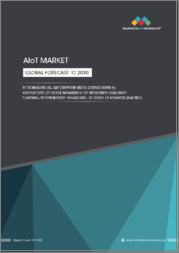
|
시장보고서
상품코드
1385551
세계의 셀룰러 IoT 연결 성장 기회Global Cellular IoT Connectivity Growth Opportunities |
||||||
5G와 LPWAN은 다양한 산업 분야에서 새로운 애플리케이션과 사용 사례를 성공시킬 수 있는 기회를 제공
세계 셀룰러 IoT 시장은 성장 단계에 있으며, 통신사들은 연결 수와 수익에서 순증하고 있으며, 2G 및 3G 네트워크 중단이라는 생태계 이니셔티브가 가속화되고 있음에도 불구하고 셀룰러 IoT 시장은 빠르게 진화하고 있습니다. 많은 개발도상국들은 저렴한 비용으로 연결성을 확보하기 위해 2G와 3G를 계속 사용하고 있습니다. 그러나 전 세계적으로 4G의 채택이 다른 무선 기술을 능가했으며, 중국에서는 2022년 NB-IoT가 가장 빠르게 성장하는 기술이 되어 전체 시장 성장에 영향을 미쳤습니다.
LTE-M은 미국 시장에서 빠르게 성장하고 있으며, 2023년 5G는 APAC, 북미, 유럽, LATAM, EMEA의 선진국에서 상용화가 시작되었고, 신흥국에서는 네트워크 구축이 계속 확대되고 있습니다. 전체 셀룰러 IoT 시장 매출은 2022년 83억 달러에서 2028년 156억 달러로 성장해 2022년부터 2028년까지 10.9%의 CAGR을 기록할 것으로 추정됩니다. 셀룰러 IoT 데이터 서비스를 제공하는 주요 통신사로는 China Mobile, China Telecom, China Unicom, AT&T, Verizon, Vodafone, Deutsche Telekom, Telefonica 등이 있습니다. 이들은 유연한 데이터 요금제, 손쉬운 구축, 고품질 연결 서비스를 제공하고, 클라우드 제공업체, 시스템 통합업체, 하드웨어 제조업체와 생태계를 구축하여 5G RedCap 및 지상 및 비지상 네트워크(NTN) 솔루션을 통한 혁신적인 솔루션을 테스트하고 있습니다. 이 시장은 소비자와 기업 모두 사용 사례에 대해 다양한 분야의 성장 기회에 영향을 미칩니다. 셀룰러 IoT는 낮은 데이터 전송을 필요로 하는 저복잡성 도입, 높은 처리량 및 저지연 장치, 지연에 민감한 애플리케이션 및 에지 컴퓨팅 등 다양한 사용 사례를 지원합니다. 이 보고서는 2022년부터 2028년까지의 매출 및 누적 IoT 연결 수 예측 분석, 부문별(프로토콜, 업종, 지역) 매출 예측, 부문별(프로토콜, 업종, 지역) 누적 IoT 연결 수 예측을 제공합니다.
목차
전략적 원칙
- 왜 성장이 어려워지고 있는가?
- The Strategic Imperative 8(TM)
- 셀룰러 IoT 연결 업계에 대한 주요 전략적 원칙의 영향
- 성장 기회가 Growth Pipeline Engine(TM)을 촉진
성장 기회 분석
- 분석 범위
- 시장 정의
- 세분화, 연결 프로토콜별
- 주요 경쟁사
- 주요 질문
- 성장 환경
- 성장 촉진요인
- 성장 억제요인
- 예측 가정
- 성장 지표
- 매출·누적 IoT 연결 수 예측
- 매출 예측, 연결 프로토콜별
- 매출 예측, 지역별
- 매출 예측, 업종별
- 누적 IoT 연결 수, 연결 프로토콜별
- IoT 누적 연결 수, 지역별
- IoT 누적 연결 수, 업종별
- 매출·누적 IoT 연결 수 예측 분석
- 매출 예측 분석, 연결 프로토콜별
- 매출 예측 분석, 지역별
- 매출 예측 분석, 업종별
- 가격 동향과 예측 분석
- 경쟁 환경
- 매출 점유율
- 매출 점유율 분석
- 누적 IoT 연결 수 점유율
- 누적 IoT 연결 수 점유율 분석
통신사업자 : 기업 개요
- AT&T
- China Mobile
- China Telecom
- China Unicom
- Deutsche Telekom
- Telefonica
- Verizon
- Vodafone
성장 기회 유니버스
- 성장 기회 1 : 효율적이고 사고 없는 운송을 위한 커넥티드/자율주행차
- 성장 기회 2 : 컴퓨터 비전 및 기타 AaaS(Analytics as a Service) 솔루션용 IoT/AI/ML 추론
- 성장 기회 3 : 생산성 향상 및 무사고를 위한 인더스트리 4.0 솔루션
- 성장 기회 4 : 시민 서비스를 개선하고 비용과 탄소 배출량을 줄이는 스마트 시티 애플리케이션
다음 스텝
ksm 23.12.055G and LPWAN Bring Opportunities for New Applications and Use Cases to Flourish in Different Verticals
The global cellular IoT market is in the growth stage, with telecom operators expanding in terms of net add connections and revenue. Despite the acceleration initiative by the ecosystem to shut down their 2G and 3G networks, the cellular IoT market is evolving fast. A large number of developing economies continue to use 2G and 3G to ensure connectivity at a low cost. However, global 4G adoption surpassed other wireless technologies, and NB-IoT became the fastest-growing technology in China in 2022, which impacted overall market growth.
LTE-M is expanding rapidly in the US market. In 2023, 5G was commercially available in the most advanced economies in APAC, North America, Europe, LATAM, and EMEA, and network rollouts continued growing in emerging economies. Total cellular IoT market revenue is estimated to grow from $8.3 billion in 2022 to $15.6 billion in 2028, expanding at a CAGR of 10.9% from 2022 to 2028. The major telecom operators delivering cellular IoT data services include China Mobile, China Telecom, China Unicom, AT&T, Verizon, Vodafone, Deutsche Telekom, and Telefonica. Besides delivering connectivity services with flexible data plans, easy deployment, and high quality, participants are developing ecosystems with cloud providers, system integrators, and hardware manufacturers to test innovative solutions with 5G RedCap as well as terrestrial and non-terrestrial network (NTNs) solutions. This market influences growth opportunities in different areas for both consumer and enterprise use cases. Cellular IoT supports a wide range of use cases, including low-complexity deployments that require low data transmission; devices with higher throughput and low latency; as well as latency-sensitive applications and edge computing. This study provides a forecast analysis of revenue and cumulative IoT connections from 2022 until 2028; revenue forecast by segments (protocol, vertical, and region); and cumulative IoT connections by segments (protocol, vertical, and region).
Table of Contents
Strategic Imperatives
- Why is it Increasingly Difficult to Grow?
- The Strategic Imperative 8™
- The Impact of the Top 3 Strategic Imperatives on the Cellular Internet of Things (IoT) Connectivity Industry
- Growth Opportunities Fuel the Growth Pipeline Engine™
Growth Opportunity Analysis
- Scope of Analysis
- Market Definitions
- Segmentation by Connectivity Protocol
- Key Competitors
- Key Questions Addressed
- Growth Environment
- Growth Drivers
- Growth Restraints
- Forecast Assumptions
- Growth Metrics
- Revenue and Cumulative IoT Connections Forecast
- Revenue Forecast by Connectivity Protocol
- Revenue Forecast by Region
- Revenue Forecast by Vertical
- Cumulative IoT Connections by Connectivity Protocol
- Cumulative IoT Connections by Region
- Cumulative IoT Connections by Vertical
- Revenue and Cumulative IoT Connections Forecast Analysis
- Revenue Forecast Analysis by Connectivity Protocol
- Revenue Forecast Analysis by Region
- Revenue Forecast Analysis by Vertical
- Pricing Trends and Forecast Analysis
- Competitive Environment
- Revenue Share
- Revenue Share Analysis
- Cumulative IoT Connections Share
- Cumulative IoT Connections Share Analysis
Telecom Operators-Company Profiles
- AT&T
- China Mobile
- China Telecom
- China Unicom
- Deutsche Telekom
- Telefonica
- Verizon
- Vodafone
Growth Opportunity Universe
- Growth Opportunity 1-Connected/Autonomous Vehicles for Efficient and Accident-Free Transportation
- Growth Opportunity 2-IoT/AI/ML Inferencing for Computer Vision and Other Analytics-as-a-Service Solutions
- Growth Opportunity 3-Industry 4.0 Solutions for Enhanced Productivity and Zero Accidents
- Growth Opportunity 4-Smart City Applications to Serve Citizens Better and Reduce Costs and Carbon Dioxide Emissions
Next Steps
- Your Next Steps
- Why Frost, Why Now?
- List of Exhibits
- Legal Disclaimer



















